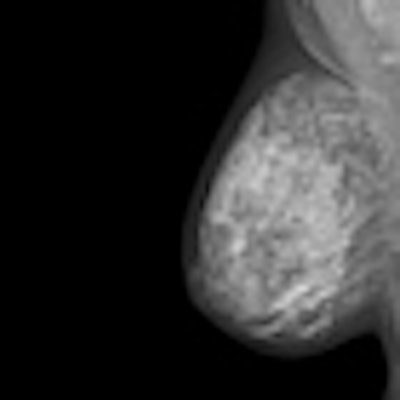
In population-based screening programs, approximately 2% of women do not return for their annual exam due to pain or discomfort, U.K. researchers said in a poster at last month's European Congress of Radiology (ECR).
The success of screening programs in reducing disease-specific population mortality depends to a large extent upon participation rates, according to Patsy Whelehan, a senior research radiographer of breast imaging, Medical Research Institute at the University of Dundee in the U.K., and Steve MacGillivray, PhD, a senior research fellow and honorary senior lecturer, Social Dimensions of Health Institute Airlie Place, also in Dundee.
 Pain keeps some women from getting their annual mammogram.
Pain keeps some women from getting their annual mammogram.
There are many reasons why some women do not attend screening programs, such as socio-economic issues, but another reason is pain.
"While there is limited evidence of effective interventions to reduce pain, the potential for intervening successfully has not been fully exploited as a focus for research," the researchers wrote. "If mammography pain were found to be an important deterrent to regular breast screening participation, this would renew the imperative to develop effective pain-reducing strategies."
Whelehan and MacGillivray conducted a systematic review of the literature in January and February of last year resulting in more than 3,000 articles but whittled these down to the 11 where women gave pain or discomfort as their reason for non-re-attendance, three of which quantified the results.
"Estimates of the proportions of women not returning for screening on account of discomfort or pain vary considerably," the researchers wrote. Methodological differences may account for some of the variation.
Despite the heterogeneity of the studies, among those with certain key characteristics in common is a degree of consistency in the results, according to the researchers. In population-based screening programs, the proportion of women who reported that pain was the reason for their actual or intended non-re-attendance ranged from 1.5 percent to 2.7 percent. However, sampling methods and response rates are a problem in some of these studies.
When focusing specifically on the women who did not re-attend, more than 40 percent gave pain as the reason.
The researchers also caution "issues such as low response rates among non-re-attenders, and in some cases the measurement of intended, rather than actual, re-attendance means that the findings should be treated with caution."
"Accurate quantification of the proportions of women who do not re-attend for breast screening on account of mammography pain remains challenging," the researchers wrote. "However, the figures indicated by the literature would represent large numbers of women being affected in the context of high-volume, population-based screening programs."
The researchers add that efforts to minimize pain from mammography should continue.



















